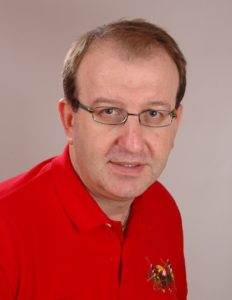Prof. Mohamed-Slim Alouini
 Mohamed-Slim Alouini was born in Tunis, Tunisia. He received the Ph.D. degree in Electrical Engineering from the California Institute of Technology (Caltech), Pasadena, CA, USA, in 1998. He served as a faculty member in the University of Minnesota, Minneapolis, MN, USA, then in the Texas A&M University at Qatar, Education City, Doha, Qatar before joining King Abdullah University of Science and Technology (KAUST), Thuwal, Makkah Province, Saudi Arabia as a Professor of Electrical Engineering in 2009. His current research interests include modeling, design, and performance analysis of wireless communication systems.
Mohamed-Slim Alouini was born in Tunis, Tunisia. He received the Ph.D. degree in Electrical Engineering from the California Institute of Technology (Caltech), Pasadena, CA, USA, in 1998. He served as a faculty member in the University of Minnesota, Minneapolis, MN, USA, then in the Texas A&M University at Qatar, Education City, Doha, Qatar before joining King Abdullah University of Science and Technology (KAUST), Thuwal, Makkah Province, Saudi Arabia as a Professor of Electrical Engineering in 2009. His current research interests include modeling, design, and performance analysis of wireless communication systems.
Keynote talk on “Unleashing the Potential of Tethered Networked Flying Platforms”
The new trend in wireless communications is enabling connectivity solutions from the sky. In this context, networked flying platforms (NFPs) including drones, balloons, and high-altitude/medium-altitude/low-altitude platforms (HAPs/MAPs/LAPs) are proposed to act as airborne base-stations (BSs) to offer 5G, beyond 5G (B5G), and 6G services. However, one of the main challenges facing the deployment of these airborne BSs is the limited available energy at the NFPs, which limits their flight and hovering time. In addition, these NFPs require an extra wireless feeder link to connect users to the core network. In this talk, we introduce the potential and advantages of tethered NFPs (t-NFPs) which are connected to a ground station through a tether. The tether provides the t-NFPs with both energy and data making them stay for a longer time in the air in order to essentially offer uninterrupted connectivity. We then discuss how the networks involving t-NFPs can be optimized to increase the efficiency of urban deployments and provide much-needed and better access in remote rural areas. We finally conclude our talk by presenting some research directions for these networks which should eventually offer a very appealing solution as a bridge between fixed base stations and free-flying platforms.
Prof. Zuqing Zhu
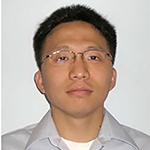 Zuqing Zhu received his Ph.D. degree from the Department of Electrical and Computer Engineering, University of California, Davis, in 2007. From 2007 to 2011, he worked in the Service Provider Technology Group of Cisco Systems, San Jose, California, as a Senior Engineer. In January 2011, he joined the University of Science and Technology of China, where he currently is a Full Professor. He has published more than 260 papers in peer-reviewed journals and conferences. He is an editorial board member of IEEE Communications Magazine, IEEE Transactions on Network and Service Management, Optics Express, Optical Switching and Networking, and others. He is a Steering Committee Member of the IEEE International Conference on High Performance Switching and Routing (HPSR), a Distinguished Lecturer of the IEEE Communications Society (ComSoc), and the Vice Chair of the Technical Committee on Optical Networking (ONTC) in ComSoc. He has received the Best Paper Awards from ICC 2013, GLOBECOM 2013, ICNC 2014, ICC 2015, and ONDM 2018. He is a Senior Member of IEEE and a Senior Member of OSA.
Zuqing Zhu received his Ph.D. degree from the Department of Electrical and Computer Engineering, University of California, Davis, in 2007. From 2007 to 2011, he worked in the Service Provider Technology Group of Cisco Systems, San Jose, California, as a Senior Engineer. In January 2011, he joined the University of Science and Technology of China, where he currently is a Full Professor. He has published more than 260 papers in peer-reviewed journals and conferences. He is an editorial board member of IEEE Communications Magazine, IEEE Transactions on Network and Service Management, Optics Express, Optical Switching and Networking, and others. He is a Steering Committee Member of the IEEE International Conference on High Performance Switching and Routing (HPSR), a Distinguished Lecturer of the IEEE Communications Society (ComSoc), and the Vice Chair of the Technical Committee on Optical Networking (ONTC) in ComSoc. He has received the Best Paper Awards from ICC 2013, GLOBECOM 2013, ICNC 2014, ICC 2015, and ONDM 2018. He is a Senior Member of IEEE and a Senior Member of OSA.
Keynote Talk on “Application-driven Virtual Network Slicing”
In this talk, we discuss recent advances on the network slicing technologies for effectively supporting emerging applications such as high-definition video streaming, virtual reality, remote surgery, etc, in future networks. Specifically, in order to satisfy the stringent quality-of-service (QoS) requirements of such applications, one needs innovation in at least three aspects, i.e., the data plane, virtualization layer, and control plane. For the data plane, we introduce the programmable data plane (PDP) techniques that can make packet processing and forwarding protocol-independent. Hence, PDP enables improved programmability, flexibility and application-awareness in substrate networks, which are the fundamental elements of network slicing. The virtualization layer needs to virtualize, allocate and isolate the resources in the substrate network to build virtual network slices according to applications’ QoS demands. Here, we discuss the open-source platforms to make the virtualization layer work seamlessly with PDP. Finally, the control plane needs to be adaptive for dynamic slicing. Therefore, we consider how to implement an intelligent control plane, which can analyze telemetry data from the data plane, and make smart and timely decisions to support various applications well.
Mohsen Guizani
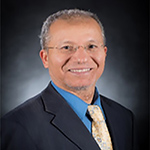 Mohsen Guizani (S’85–M’89–SM’99–F’09) received the B.S. (with distinction) and M.S. degrees in electrical engineering, the M.S. and Ph.D. degrees in computer engineering from Syracuse University, Syracuse, NY, USA, in 1984, 1986, 1987, and 1990, respectively. He is currently a Professor at the Computer Science and Engineering Department in Qatar University, Qatar. Previously, he served in different academic and administrative positions at the University of Idaho, Western Michigan University, University of West Florida, University of Missouri-Kansas City, University of Colorado-Boulder, and Syracuse University. His research interests include wireless communications and mobile computing, computer networks, mobile cloud computing, security, and smart grid. He is currently the Editor-in-Chief of the IEEE Network Magazine, serves on the editorial boards of several international technical journals and the Founder and Editor-in-Chief of Wireless Communications and Mobile Computing journal (Wiley). He is the author of nine books and more than 600 publications in refereed journals and conferences. He guest edited a number of special issues in IEEE journals and magazines. He also served as a member, Chair, and General Chair of a number of international conferences. Throughout his career, he received three teaching awards and four research awards. He is the recipient of the 2017 IEEE Communications Society Wireless Technical Committee (WTC) Recognition Award, the 2018 AdHoc Technical Committee Recognition Award for his contribution to outstanding research in wireless communications and Ad-Hoc Sensor networks and the 2019 IEEE Communications and Information Security Technical Recognition (CISTC) Award for outstanding contributions to the technological advancement of security. He was the Chair of the IEEE Communications Society Wireless Technical Committee and the Chair of the TAOS Technical Committee. He served as the IEEE Computer Society Distinguished Speaker and is currently the IEEE ComSoc Distinguished Lecturer. He is a Fellow of IEEE and a Senior Member of ACM.
Mohsen Guizani (S’85–M’89–SM’99–F’09) received the B.S. (with distinction) and M.S. degrees in electrical engineering, the M.S. and Ph.D. degrees in computer engineering from Syracuse University, Syracuse, NY, USA, in 1984, 1986, 1987, and 1990, respectively. He is currently a Professor at the Computer Science and Engineering Department in Qatar University, Qatar. Previously, he served in different academic and administrative positions at the University of Idaho, Western Michigan University, University of West Florida, University of Missouri-Kansas City, University of Colorado-Boulder, and Syracuse University. His research interests include wireless communications and mobile computing, computer networks, mobile cloud computing, security, and smart grid. He is currently the Editor-in-Chief of the IEEE Network Magazine, serves on the editorial boards of several international technical journals and the Founder and Editor-in-Chief of Wireless Communications and Mobile Computing journal (Wiley). He is the author of nine books and more than 600 publications in refereed journals and conferences. He guest edited a number of special issues in IEEE journals and magazines. He also served as a member, Chair, and General Chair of a number of international conferences. Throughout his career, he received three teaching awards and four research awards. He is the recipient of the 2017 IEEE Communications Society Wireless Technical Committee (WTC) Recognition Award, the 2018 AdHoc Technical Committee Recognition Award for his contribution to outstanding research in wireless communications and Ad-Hoc Sensor networks and the 2019 IEEE Communications and Information Security Technical Recognition (CISTC) Award for outstanding contributions to the technological advancement of security. He was the Chair of the IEEE Communications Society Wireless Technical Committee and the Chair of the TAOS Technical Committee. He served as the IEEE Computer Society Distinguished Speaker and is currently the IEEE ComSoc Distinguished Lecturer. He is a Fellow of IEEE and a Senior Member of ACM.
Keynote Talk on “Security Schemes for Healthcare Devices in the IoT Era”
Internet of Things (IoT) is transforming our society and daily lives by connecting the world. This is expected to fundamentally transform industry, business, transportation and healthcare. However, this ubiquitous connection brings with it many challenges that range from security, scalability, data analytics, to device-level protocols. It is estimated that there will be hundreds of billions of IoT devices that need to be connected in the next few years. In addition, more than half of the world’s population live in cities, many with multiple devices that need to be connected to the Internet. This is expected to create a complex infrastructure. These smart services rely on computation and communication resources. Furthermore, being able to provide adequate services using these complex systems present enormous challenges.
In this Keynote, we review the current efforts by experts around the world to mitigate some of these challenges. Then, we showcase our research activities to contribute to these efforts and advocate possible solutions using AI and other tools. We provide ways on how to manage the available resources intelligently and efficiently in order to offer better living conditions and provide better services. Finally, we discuss some of our research results to support a variety of applications including how to secure these devices for successful healthcare service delivery in different aspects.
Christos Verikoukis
Christos Verikoukis got his PhD from the Signal Theory and Communications Department of the Technical University of Catalonia (UPC), Barcelona, in 2000, in the area of Broadband Indoor Wireless Communications. He joined CTTC on February 2004 and he is currently a fellow researcher and head of the SMARTECH department. Since 2007 he has been an adjunct associate professor at Barcelona University (UB). Dr Verikoukis has participated or is currently participating in several European and National funded projects.
He has received the best paper award of the Communication QoS, Reliability & Modelling Symposium (CQRM) symposium in the IEEE ICC 2011 & ICC 2014, of the Selected Areas in Communications Symposium in the IEEE GLOBECOM 2015 , of the EUCNC 2016 conference, the EURASIP 2013 Best Paper Award for the Journal on Advances in Signal Processing and the Best Demo Award in IEEE CAMAD2018.
He is currently serving as the Associate Editor-in-Chief of the IEEE Networking Letters and as an Associate Editor of the IEEE Communications Surveys and Tutorials, of the IEEE Networks Magazine and of the IEEE Transactions of Green Communications and Networking. Moreover, he has served as a Guest Editor in 14 special issues in prestigious Journals and Magazines (IEEE Communications Magazine, IEEE Networks Magazine, IEEE Wireless Communications Magazine etc..).
He was the general Chair of the 17th, 18th, 19th, 20th and the 22nd IEEE Workshop on Computer-Aided Modelling, Analysis and Design of Communication Links and Networks (CAMAD), the TPC Co-Chair of the 15th IEEE International Conference on eHealth Networking, Application & Services (Healthcom) and the 7th IEEE Latincom. He was also served as the symposium co-chair of the CQRM symposium in the IEEE ICC 2015 & 2016 and in the IEEE Globecom 2017 as well as of the eHealth Symposium in IEEE Globecom 2015.
He was an officer (Secretary 2013-2014, Vice-Chair 2014-2015 and Chair 2015-2018) of the IEEE ComSoc Technical Committee on Communication Systems Integration and Modelling (CSIM) and Vice-Chair of the IEEE ComSoc Technical Committees Board (2019-2020) He is currently a a Member of the IEEE ComSoc Board of Governors, Member-at-Large of the IEEE ComSoc GITC and IEEE ComSoc EMEA Director.
Keynote Talk on “Cooperative Energy Management in Smart Cities”
Smart grids are the key solution to the numerous challenges that the electric power industry confronted. The aging infrastructure, the increasing demands for energy, the limited energy resources, as well as environmental concerns have affected the reliability of the existing power grid. In parallel, the rise of new types of loads, such as electric vehicles, will further increase the margin between the installed power capacity and the maximum power output. The improvement of the conventional power grid is therefore essential, targeting to increase the consistency and the efficiency, while providing resilience to equipment failures. The intelligence of the smart grid is the key factor for the provision of improved control, efficiency and safety, through the incorporation of advanced two-way communication capabilities.
As the smart grid concept continues to evolve, various methods have been developed in order to support the current infrastructure, such as distributed energy generation, energy storage, smart pricing and demand response (DR). DR refers to a procedure that is applied in order to motivate changes in the customers’ power consumption habits in response to incentives regarding the electricity prices. In this speech, we aim to present a comprehensive review of the emerging DR solutions that have been proposed or even become available over the last years. Moreover, the speech covers the new trend on energy management in cities that is based on the cooperation of buildings as an alternative solution for the optimum management of the energy generated, stored and consumed in urban buildings. The applicability and effectiveness of cooperative energy management systems is demonstrated through Barcelona’s unique smart community planning model of “Superblocks”. Since the issue of energy consumption management is of extreme interest both from the research community as well as industry, the proposed tutorial surely covers a timely topic, and it can provide useful hints to researchers on available research lines and industrial developer on most recent and promising advances in the fields.
Winston Seah
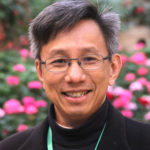 Winston K.G. Seah received the Dr.Eng. degree from Kyoto University, Kyoto, Japan, in 1997, and ME and BSc degrees from the National University of Singapore in 1993 and 1987 respectively. In 2009, he joined Victoria University of Wellington, New Zealand as Professor of Network Engineering. Prior to this, he has worked for more than 16 years in mission-oriented industrial research, taking ideas from theory to prototypes, most recently, as a Senior Scientist (Networking Protocols) in the Institute for Infocomm Research (I2R), Singapore. Being actively involved in research in the areas of mobile ad hoc and sensor networks, he co-developed one of the first Quality of Service (QoS) models for mobile ad hoc networks and was one of the first to study networking protocols for wireless sensor networks powered solely by ambient energy harvesting. His latest research focuses on networking protocols and the use of artificial intelligence and machine learning techniques to address the needs of 5G networks, Internet of Things (IoT) and other machine-type communications (MTC), encompassing both short range technologies (e.g. IEEE802.15.4, 6LoWPAN, and RPL) as well as, long-range communications (such as, LTE-A, NB-IoT, LoRaWAN, and IEEE802.11ah.) He is a Senior Member of the IEEE and Professional Member of the ACM.
Winston K.G. Seah received the Dr.Eng. degree from Kyoto University, Kyoto, Japan, in 1997, and ME and BSc degrees from the National University of Singapore in 1993 and 1987 respectively. In 2009, he joined Victoria University of Wellington, New Zealand as Professor of Network Engineering. Prior to this, he has worked for more than 16 years in mission-oriented industrial research, taking ideas from theory to prototypes, most recently, as a Senior Scientist (Networking Protocols) in the Institute for Infocomm Research (I2R), Singapore. Being actively involved in research in the areas of mobile ad hoc and sensor networks, he co-developed one of the first Quality of Service (QoS) models for mobile ad hoc networks and was one of the first to study networking protocols for wireless sensor networks powered solely by ambient energy harvesting. His latest research focuses on networking protocols and the use of artificial intelligence and machine learning techniques to address the needs of 5G networks, Internet of Things (IoT) and other machine-type communications (MTC), encompassing both short range technologies (e.g. IEEE802.15.4, 6LoWPAN, and RPL) as well as, long-range communications (such as, LTE-A, NB-IoT, LoRaWAN, and IEEE802.11ah.) He is a Senior Member of the IEEE and Professional Member of the ACM.
Keynote Talk on “Making Sense out of IoT Non-Sense”
The Internet has transformed from its original form that connects computers utilized by humans to one that connects objects, sensors, and any foreseeable device in everyday life, giving rise to the “Internet of Things”. Coined by Kevin Ashton in 1999, the term “Internet of Things” (IoT) refers to this new Internet where devices generate data and communicate, interacting often without any human intervention. Industry and academia alike have exploited IoT in marketing and securing grants respectively, purporting numerous new futuristic IoT products and research as far-fetched as IoT storytelling!!! This talk aims to put some context into the different definitions of IoT, the research challenges, and hopefully make some sense out of IoT “non-sense”.
Colin Perkins
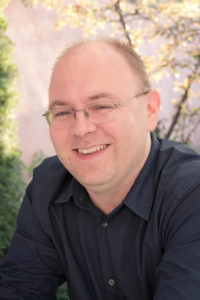
Colin Perkins is an Associate Professor in the School of Computing Science at the University of Glasgow and the current chair of the Internet Research Task Force IRTF. His research interests include network transport protocols, with a focus on real-time networked multimedia, and improving the way network protocols are designed, implemented, and specified. He’s a long-time participant in the IETF, where he co-chairs the real-time media congestion control working group, and played a key role in helping to develop globally deployed standard multimedia transport and signalling protocols such as RTP, SDP, and the WebRTC media transport layer. Dr Perkins received his PhD from the University of York in 1996. He’s a senior member of the IEEE, and a member of ACM and IET.
Keynote Talk on “At the intersection of research and standards: an introduction to the IRTF”
The network research community and the engineers that design, build, and operate the Internet infrastructure can often seem to inhabit different worlds. Some view academic research as being out of touch with real problems; others can view the concerns of implementers and operators as details unworthy of detailed study. In this talk I’ll argue that both communities benefit from increased interaction and cooperation, and highlight some of the benefits that come from working at the intersection of research and standards. I’ll introduce the Internet Research Task Force (IRTF), and highlight some opportunities the IRTF provides for researchers to increase the impact of their work by engaging with, learning from, and influencing the Internet standards community.
Robin Marx
Robin Marx is a fourth-year PhD student at Hasselt University in Belgium, researching Internet protocols. He has mainly been looking at HTTP/2, QUIC and HTTP/3 and creates tools that help him and others debug their behavior and performance. In a previous life he was a multiplayer game programmer and co-founder of LuGus Studios. YouTube videos of Robin are either humoristic technical talks or him hitting other people with longswords.
Keynote Talk on “An Academic’s Guide to QUIC”
The new QUIC transport protocol is the hottest thing since sliced bread. Promising a plethora of powerful performance and security improvements on the old and boring TCP, it is poised to revolutionize the Internet and bring about world peace.
Yet, will that actually happen? And what exactly are QUIC and its HTTP/3 counterpart? What are these exciting new features and how do they work? And especially: what’s in it for the hardworking academic?
In this presentation, I will take you on a whirlwind tour through the magical, mystical wonderland of modern network protocols. Together, we explore the mysteries of complex features such as stream multiplexing, 0-RTT connection establishment, multipath transport, and 39 other interesting concepts.
We follow in the footsteps of those brave researchers that have come before, discover how far they got in their quest, and especially discuss how you might practically jumpstart your own expeditions to uncover QUIC’s many remaining hidden secrets (treasuremap sold separately).
Throughout, I will also regale you with my personal campfire stories of how a starry-eyed PhD explorer ended up collaborating with actual Wizards on the strange island of the Internet Engineering Task Force (IETF) and how you can (and should) do the same.
So, dig up your sense of adventure, carry a towel, and QUICkly join this expedition!



